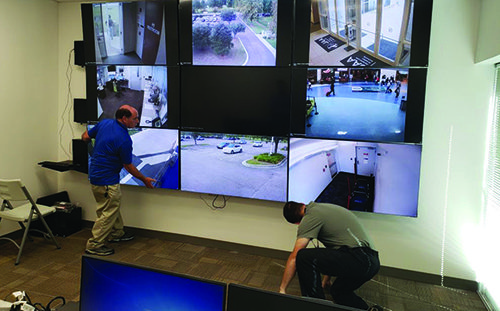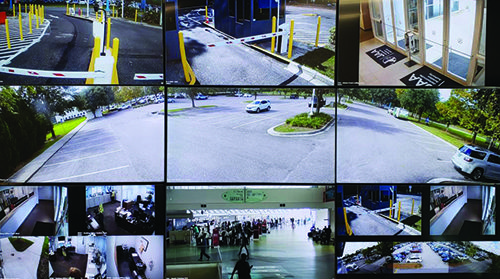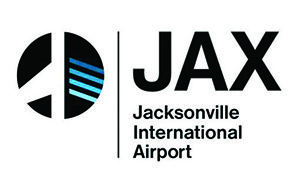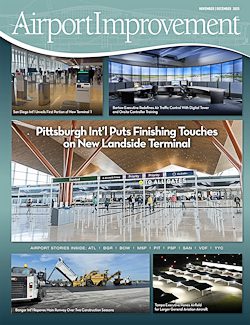It’s not every day that an airport installs a new security video system that covers practically all public areas within the facility. But this is exactly what Jacksonville International Airport (JAX) in Florida has done.
 The $7.5 million system, which went online in September, tripled the number of cameras in use from 300 views to 1,200 views and made it possible to track passengers throughout the airport, from the parking garage to their planes. It also converted JAX from an analog system to digital.
The $7.5 million system, which went online in September, tripled the number of cameras in use from 300 views to 1,200 views and made it possible to track passengers throughout the airport, from the parking garage to their planes. It also converted JAX from an analog system to digital.
Airport Chief Executive Officer Steve Grossman offers a history lesson to delineate the need for change. Prior to 9/11, airport security systems were designed to stop hijackings. In fact, “that’s why security checkpoints were brought into play,” he explains. “They were designed to stop bad things from going through a checkpoint that someone could use to hijack a plane.”
|
Project: Video Surveillance System Replacement Location: Jacksonville (FL) Int’l Airport Cost: $7.5 million Funding: $3.3 million – FAA Airport Improvement Program; $4.2 million – passenger facility charges Project Timeline: Request for quotes Jan. 2015; contract issued Oct. 2016; project completed Oct. 2018 Project Design, Engineering & Construction Management: Johnson Controls Inc. (originally Tyco Integrated Security) System Design, Quality Monitoring & Final Testing Assistance: RS&H Network Design, Engineering & Installation: Presidio Networked Solutions Electrical Design, Installation & Testing: Vanguard Electric New System: Unified Management System, from Tyco Security Products System Components: 1,200 video camera views; 28 operator workstations: 20 wall monitors; 63 network switches; 4 petabytes of video storage Cameras: American Dynamics (fixed domes & pan/tilt/zoom); Axis (multi-lens); FLIR (thermal) Installation Materials: Approx. 33 miles of conduit; 4,000 feet of 120-volt power/connections; 42.9 miles of category 6 cable; 5.5 miles of fiber |
But after the Twin Towers fell in 2001, the focus shifted from stopping hijackers to stopping would-be terrorists at the airport door.
In 2014, the guiding strategy evolved again, after two men managed to use an employee badge, backpack and cellphones to thwart security and smuggle guns from Atlanta to New York.
“The focus went from just stopping terrorism to also preventing crime,” Grossman says. “In our case, it required a change in philosophy. We knew we had a rather outdated closed-circuit TV system; but with this new directive, we wanted to be able to follow a person from the moment they came onto the airport to the time they left. If they are carrying something they shouldn’t be carrying, we want to know immediately—not after the fact.”
The resulting system, which was two years in the making, offers end-to-end video coverage at JAX, notes Sam Brunetti, project manager at the airport for the Government Technologies Group of Johnson Controls Inc. Security Solutions. “We have cameras to view cars as they enter the garages, where we actually log their license plate numbers in and out of the garage. We have cameras that cover every crosswalk, every door opening, every walkway,” explains Brunetti. “I don’t want to use the words ‘100%,’ but there are very few places within the airport public areas that are not covered by cameras. That was ultimately the goal: to provide camera coverage that can identify an individual and then, by a camera-by-camera basis, know where they are at, and where they are going.”
Within weeks of deployment, JAX had already reaped the new system’s benefits. When someone mailed a suspicious envelope to the airport, police were able to identify the individual from video footage. When a passenger was injured at the airport, officials were able to quickly retrieve video footage to learn when and where it took place.
“Security is an important reason for this project,” Brunetti says. “But just as important is that it offers the ability to cover an incident, such as someone falling or getting caught in an escalator, from the airport’s perspective.”
Project Partners
With its nearly 20-year-old analog video system reaching the end of its life, JAX wanted to install a new video system with updated digital technology. “The cameras needed to be newer, the format that the cameras operated in needed to be newer, and the way that data was physically gathered from the cameras and stored needed to be newer,” Brunetti elaborates.
Airport officials structured the upgrade as a design-build project, and Johnson Controls won the business after a request for quotes that was issued in 2015. The airport teamed with Johnson Controls to develop a game plan based on the Jacksonville Aviation Authority information technology roadmap related to systems consolidation and integration. “Our purpose was to work with the airport to build a game plan that took what they needed and fit it into the budget they had,” explains Frank Pervola, the company’s transportation business development manager.
Part of the strategy was to keep the contracting team as local as possible, with Johnson Controls acting as the prime contractor overseeing the project. RS&H served as the subcontractor that designed the system, monitored quality and assisted with final system testing. Presidio Networked Solutions acted as the networking subcontractor responsible for designing, engineering and installing the network. Johnson Controls tapped Vanguard Electric for electrical design, installation and testing.
The airport had recently upgraded its existing C-Cure access control system, so ensuring that the new cameras interfaced with that system was a key priority.
Another requirement was to use off-the-shelf options for peripheral equipment, such as field cameras. “Airport officials didn’t want to use proprietary systems,” Pervola explains. “They wanted to be sure they could get the equipment they needed from just about anyone.”
Finally, while JAX sought leading-edge technology, it also wanted equipment with a successful track record in airport environments. The team selected American Dynamics and Axis security cameras to fulfill both requirements.
Timing was also considered, notes Grossman. Although the security system had been an identified need for about a decade, he wanted to incorporate new technology at just the right time. “You don’t want to take two years to do a project, as we did here, and then on the day you are done, have the technology be three generations out of date,” he explains. “We were very careful with our timing to ensure the technology would be long-lasting.”
Unification a Must
The previous system at JAX included stand-alone video and access control systems, with a separate interface that enabled each to receive input from the other. Leveraging unification, the two new systems work together. “Although they have their own capabilities and functionality, they are integrated together on the same platform,” says Brunetti.
“We did not want two systems that were forced to talk to each other, and then have to support third-party integration and figure out how to keep that working,” adds Grossman. “We selected products that had the integration built in. With this project, we have laid the groundwork for complete integration over time. This is the first step, and eventually we will be able to tie in other things such as our fire alarm system or our building maintenance system. It’s a true value to personnel who monitor all of this.”
Unification also simplifies system updates. For example, when operators update the access control system, the security camera system is updated accordingly. “In the past, if you updated one system, you had no idea how it would affect the other system,” states Brunetti.
These benefits are not lost on Rick Hill, information technology project manager at JAX. “Rather than manage, administer and maintain two separate systems, we have combined the two,” says Hill. “They use the same server and the same database. We don’t have to switch between two separate boxes or two separate operating systems; it all happens internally.”
The advantages of unifications are especially evident when an alarm is triggered. For instance, if a door alarm goes off, the associated camera pops up, monitors the area and sends a notice to the Airport Operations Control Center (AOCC), where workers monitor incoming video 24/7. Employees can also call up footage from other cameras as needed.
“The AOCC has immediate eyes on what’s happening, whether it’s someone with a security badge who propped open a door, or someone who held the door open for [nefarious] reasons,” Hill explains. With the new system, AOCC personnel can zoom in on badge numbers and faces to compare with airport records.
“Previously, we had a door alarm system that did not sync up with the camera system, so officials had to monitor multiple systems separately,” states Grossman. “As we move forward, all of our systems are going to be integrated, so the person sitting
in our operations control center can monitor all of them—and do so easily.”
Selecting & Placing Tech
According to Grossman, the “secret” to the project’s success was involving all users from the beginning to determine what kind of visuals they needed to do their jobs effectively. Key groups included the security department, operations department and TSA.
The project team examined the cameras already in place, determined where more were needed and maximized coverage by increasing the number of views from individual cameras. Often, designers opted for cameras with 180-degree views, versus installing three separate cameras to achieve the same coverage.
System designers used architectural drawings of the airport to consider where video coverage was needed, and then asked key users exactly what they needed to see in these areas, to help determine camera placement. “Our engineering people set locations for the cameras, and then we would work together as a team to refine the plan,” recalls Brunetti.
The resulting system utilizes five different camera types. Equipment ranges from 2-megapixel fixed units to 33-megapixel, 180-degree cameras, Axis multi-lens cameras and American Dynamics pan-tilt-zoom (PTZ) cameras. “The PTZ cameras can clearly see the numbers on planes on the runway,” says Hill.

The view being sought in a specific location ultimately determined the type of cameras used. For example, a camera monitoring one specific door requires less megapixels than a camera capturing a 180-degree view of a gate. Airfield cameras needed a wide field of view, but also required additional protection from the elements, particularly jet fuel, to prevent clouding and corrosion.
“On the airfield, you want to eliminate cost and the need for extensive repair by reducing the number of cameras by increasing the field of view for each unit,” explains Brunetti. “We looked at how we could get one camera with three elements built inside to span a much larger area, provide the needed views, zoom in and out, while also reducing maintenance needs.”
Maintenance was top of mind, because cameras were placed high inside terminal buildings and on jet bridges. “They are not easy to reach,” he says. “By reducing the numbers but increasing the capabilities, we reduce maintenance needs and costs in the long run.”
Using IP (Internet protocol) cameras allows personnel to remotely tweak the equipment’s field of view after installation. “Once a camera is installed, we don’t have to go out and physically move it a foot to the left or the right. We can make those changes electronically in an app,” comments Brunetti. “That’s what the airport was looking for: flexibility within the cameras to refine the view without physically having to go out and move them.”
Each camera offers full-size internal storage. Some store 30 days of footage, while others store content for 90 days. The airport also has four petabytes of video storage to store required video.
Behind the Scenes
Infrastructure changes were needed to ready the airport for its new system. Previously, all information technology (IT) systems were fed into a data center housed in the terminal. If that center went down, all IT systems went down. Six years ago, the airport began updating its IT infrastructure to ensure this couldn’t happen.
 “One of the early projects was to move admin divisions to a separate office building and add a data center there that all systems fed into,” says Steven Schultz, director of IT at the airport. “We switched everything over to that, then rebuilt the terminal data center to serve as backup. If any systems fail in the admin building server room, they will run out of the terminal data center, without users seeing a noticeable change in performance. And, through virtualization technology, software and hardware can be upgraded independently, making future upgrades easier and less costly.”
“One of the early projects was to move admin divisions to a separate office building and add a data center there that all systems fed into,” says Steven Schultz, director of IT at the airport. “We switched everything over to that, then rebuilt the terminal data center to serve as backup. If any systems fail in the admin building server room, they will run out of the terminal data center, without users seeing a noticeable change in performance. And, through virtualization technology, software and hardware can be upgraded independently, making future upgrades easier and less costly.”
The security system tied easily into this existing backbone, he adds. Even so, the project required JAX to install or replace approximately 63 network switches and 20 wall monitors. Crews also added approximately 42.9 miles of category 6 cable and 5.5 miles of fiber.
“We went with cat 6 cable versus cat 5 so that we could move the maximum amount of data over it, which becomes very important when you are talking about cameras that have three sensor elements in them,” Brunetti says. “That’s an extreme amount of information over a single line. This installation will help us easily move the airport toward the future.”
Grossman Retires in October
|


 facts&figures
facts&figures

